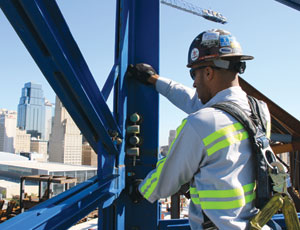Hanging more than 200 ft over a jobsite in down- town Kansas City, Mo., James Hague doesn’t seem to notice the amount of air separating him from the people below. The senior technician fiddles with a dial gauge that measures the amount of play in the crane turntable, the giant gear that rotates the jib. “A bearing could go bad,” he says, suspended from a full-body harness. “And that’s something we want to know before the top falls off.”
Although this vertigo-inducing procedure is not required for a routine inspection, it is standard practice at Kansas City-based J.E. Dunn Logistics Inc., which is stepping up its safety program in an effort to cut risks, especially around its expensive hoisting equipment. Others doing similar work say the downturn provides the perfect time to increase safety controls before the market rebounds. Ensuring worker safety around heavy machinery is becoming a more digitized process, enabling new controls. After Hague performs an inspection for one of the cranes, he climbs down, slips off his gloves, sits in his pickup truck and enters his findings in a smart phone or laptop. In seconds, an electronic report shoots off to a file server in the home office.
J.E. Dunn’s safety managers can then pull reports on the company’s fleet of 31 tower cranes, from anywhere in the U.S., using a secure Internet site. In the past, Hague and the firm’s other half-dozen inspectors would fill out a paper that eventually would be filed away in a cabinet. “I can tell you that we have had a very, very aggressive inspection program for years,” says Dan Euston, president of general contractor J.E. Dunn Construction, the logistic unit’s parent. “It’s just becoming more formalized and stringent as we’ve started sending more tower cranes around the country.”
After a spate of catastrophic crane accidents rocked the construction industry in 2008, contractors are boosting their quality control and quality assurance —and trying to go above and beyond current safety standards around cranes. “We felt that that was an area of the industry that had risk,” Euston explains.
Far away from Kansas City, a large crane-rental company in Salem, Ore., is on a similar track. There, Morrow Equipment Co. is putting its workers through a program housed in a newly built, 9,000-sq-ft training center it finished erecting last summer. Among the classes are seminars on fall protection, rigging, lockout-tagout and electrical protection—fundamental training in areas that clients, regulators and insurers have pinpointed as risky. Nearby, at the company’s maintenance shop, a new system of red, blue and green stickers, which inspectors must sign and date, indicates whether or not tower-crane parts are safe to go out into the field.
Both J.E. Dunn and Morrow clearly are boosting quality assurance, acting because clients, insurers and regulators are asking for more of this documentation. “We have to be diligent in maintaining our equipment and erecting equipment that we truly know—not that we believe—but that we truly know is safe,” says Peter Juhren, Morrow’s corporate service manager. “The accountability is the largest part of this new process.”
Plugged In
Kansas City is well known for blues, jazz and barbecue, but towering above the skyline are J.E. Dunn’s familiar fleet of royal-blue cranes, believed to be the country’s largest tower-crane fleet to be owned by a general contractor. Made by Spain-based Linden Comansa, the cranes have a signature “flat top” design, meaning they use no overhead wires to support the jib.
�I think it�s a complete coincidence that the cranes are blue and our company colors are blue,� says Cory Hall, safety manager for J.E. Dunn Logistics. �It�s just been a part of the culture.� What locals probably don�t notice is the invisible web that now connects these cranes: The digital initiative began three years ago for general safety compliance and expanded last year for the firm�s hoisting fleet.
“In the past, when technicians go out to inspect a crane, they have a paper report that they fill out, and basically it’s filed away,” Hall says, adding that J.E. Dunn inspects its tower cranes every six weeks, or 300 hours. Federal guidelines require only annual inspections. The company also performs nondestructive testing of the structure after each project.
J.E. Dunn has been using a software program called DB0² to track its general safety compliance. In 2008, it asked the program’s San Carlos, Calif.-based supplier to retool to support the hoisting fleet. “We can pull statistics and data, everything from fall protection to crane inspection,” says Hall. “Once a crane is moved, those statistics…follow that crane to the next job.”
The equipment is hooked up to mobile GPS trackers, too. That may sound especially strange for tower cranes as they almost always work from a stationary position. But the tracking devices monitor essential data points, such as load testing. Every day, J.E. Dunn requires its operators as part of their startup routine to test the crane to 110% of its rated capacity. Industry standards only require this procedure upon initial erection of the crane.
The routine works like this: The operator instructs a rigger on the ground to hook up a dedicated test block that weighs the same amount at the crane’s maximum rating. Tethered to it is a smaller “pup” weight that adds 10% more. The operator lifts the test weight, and when the chains pull tight on the pup, the crane’s limit switch trips, shutting it down. If not, the operator knows something is wrong.
This method is controversial in some circles of crane experts because it potentially exposes the crane to premature fatigue. But it is perfectly legal as long as the manufacturer does not prohibit it. Operators that use the method say...



Post a comment to this article
Report Abusive Comment